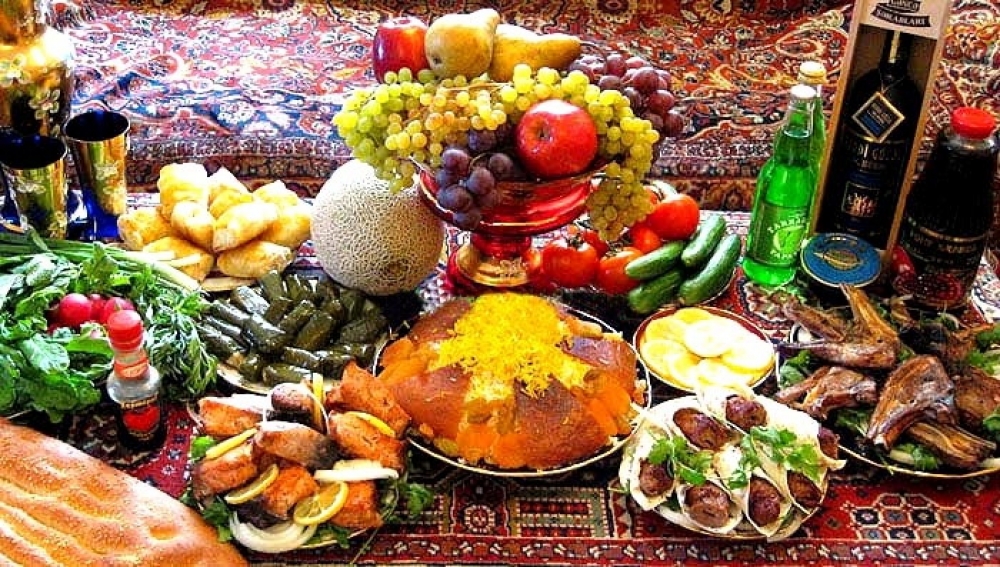ID :
626640
Thu, 03/31/2022 - 13:54
Auther :
Shortlink :
http://m.oananews.org/index.php//node/626640
The shortlink copeid
Karabakh cuisine-2

Baku, March 31, AZERTAC
Archaeological and historical studies show that over the millennia, the culinary culture of Karabakh has maintained its traditional look. Excavations in the settlement of Chalagantapa indicate that materials from different layers (horizons) do not differ from each other. From the time it was founded (6th-5th millennia B.C.), the ancient population of Chalagantapa was familiar with the culture of farming, cattle-breeding, mining and stone and bone processing techniques.
Sources note the high agricultural culture of Karabakh residents. On irrigated land, they cultivated wheat, rice, cotton and mulberry. Mirza Jamal Javanshir (1773-1855) recorded in his book "The History of Karabakh" that one-fourth of seeded wheat provides 20 quarters of the harvest there. An especially rich harvest is yielded by rice and millet (over 50 quarters for one quarter). In addition, he points to large herds of cattle and sheep and goats. The population of Karabakh ate various wild grasses and cultivated greens.
Karabakh cuisine also widely used dried fruit, and it was served as a dessert. It was used to make khoshab (compote) and was added to the pilaf, soups, meat and other dishes. At the All-Russian Exhibition in Moscow in 1882, Karabakh fruits - Cornelian cherries, mulberry and cherry plum lavashana (sour candy), made by the daughter of the Karabakh khan - poetess Khurshudbanu Natavan, were put on display. Having visited Azerbaijan, Alexander Dumas (father) and the painter Monet met with her, and Dumas described this meeting in his book "Journey to the Caucasus". Lavashana was borrowed by Slavic cuisine from Azerbaijani cuisine: it is mentioned in "The Domostroy" under the name of "levashinki."
The Arab author Ibn Haukal (9th century) recorded that Barda chestnuts were larger and more productive than Syrian ones. This is confirmed by Hamdallah Qazvini, who writes about Barda in his essay "Nuzhan al-Qulub" ("Delight of Hearts") (14th century): "There are a lot of fruits here, especially nuts and chestnuts, which are better than anywhere else." His words are confirmed by other Arab travelers. The Arab traveler Al-Istahri (10th century) recorded in his "Kitab Masalik al-Mamalik": "If we talk about Barda, it is a place with a healthy climate, fertile, arable land and multiple fruits, and less than one farsakh from Barda, in the town of Andarab, there is a wide network of gardens and plantations where they grow melons and all kinds of fruit. The local hazelnut is better that those from Samarkand, while chestnuts are better than those from Sham. Another fruit, called "ruchal" (zugal, zogal - Cornelian cherry - T.A.), grows here.
"The chestnut is half the size of the black walnut and tastes like persimmon and hazelnuts. Figs are brought to Barda from Lasub. This is the best fig. There are many ownerless mulberry trees here." The Arab traveler Al-Muqaddasi writes about Barda in the 10th century: "Barda is a nice and beautiful city rich in fruits. It is a nice city with beautiful pastures and two rivers running through it: the faces of its inhabitants are like a pearl and coral, and they are also generous and merciful. "In Barda, there is a Sunday market called 'Kurkiyu'... There is nothing like the fruit called 'zukol'. They have figs and chestnuts of extremely good quality." Ibn Haukal (10th century) also wrote about Barda. "In Barda ... there are nuts and shihaballut (chestnut – T.A.), which stand above the Syrian shihiballut in size, charm, taste and abundance of fruits. They grow 'zukal' (apricot), which is the size of 'gubeyra'. It has a date seed and tastes sweet when it is ripe. In Barda, figs are imported from Lasub, their mulberry trees are available to the public, and they do not have owners and are not sold or bought." Nizami Ganjavi added in the 12th century: "How wonderful and glorious Barda is. And flowers bloom here in winter and summer." The 17th century traveler Evliya Chelebi records: "Karabaglar… a gardener named Yazdon–gulu brought us 26 varieties of juicy pears. Trying the 'malanja', 'abbasi' and 'ordubadi' pears, you feel the taste of a candy in your mouth. There are pomegranates like a ruby. The chefs are clean and all Muslims." In another place, he says: "Karabakh includes separate sultanates in the possessions of Tabriz. Food and drinks deserve commendation. There are 10 sorts of juicy, ruby-colored grapes; cherry syrup, soft drinks; 18 kinds of delicious juicy pomegranates. The local quince the size of the human head is famous."
To be continued





